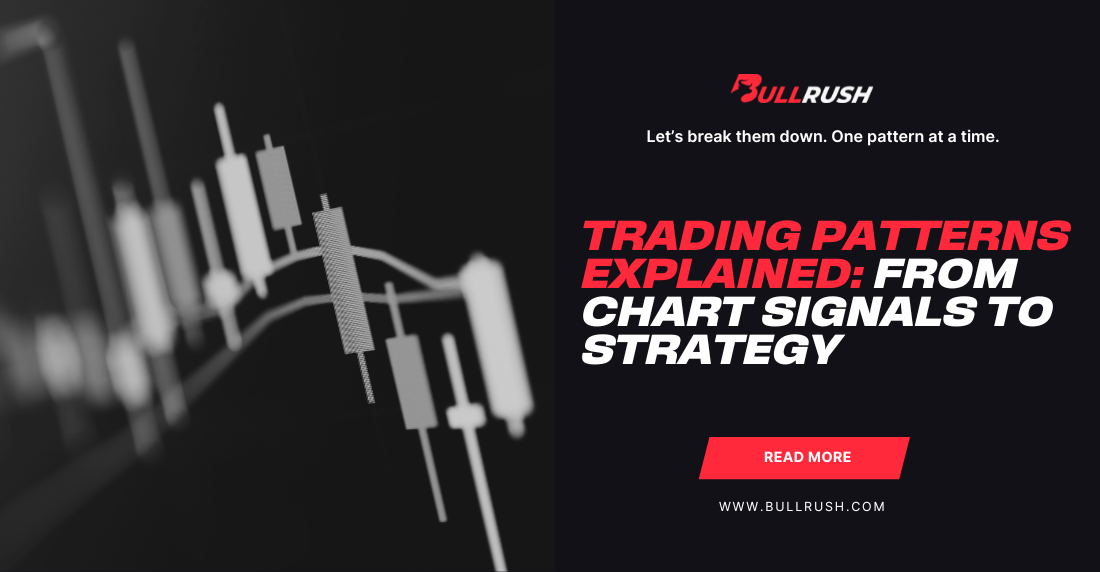
Trading Patterns Explained: From Chart Signals to Strategy
Every chart tells a story of fear, greed, hesitation, and momentum. If you know how to read that story, you hold one of the most powerful tools in trading: patterns.
Trading patterns are the marks that market psychology leaves behind, ranging from dramatic breakouts to nuanced reversals. They indicate where traders are backing off, where they are swarming in, and where the next big move may start.
Whether you are a day trader watching minute-by-minute action or a swing trader scanning daily charts, understanding trading patterns helps you see structure in chaos and trade with precision instead of guesswork.
Let’s break it down. One pattern at a time.
What Are Trading Patterns? The Market’s Hidden Language
Trading patterns are visual formations on price charts when buyers and sellers clash for control. They highlight patterns in market behavior, such as how prices respond to optimism, fear, or fatigue.
Every pattern tells a story. Some are continuation patterns like flags or triangles, where the market takes a breather before resuming the trend. Others are reversal patterns, such as head and shoulders or double bottoms, when momentum runs out and direction changes.
Think of it like weather forecasting for markets. Clouds, wind, and pressure patterns hint at storms. In trading, chart patterns hint at where price shifts are ready to happen.
Tip: Always confirm a pattern with volume or strong price action. A pattern without conviction is just a decoration.
The Classic Patterns Every Trader Should Know
Let’s look at the hall of fame patterns common across all markets: from crypto to stocks to futures.
Head and Shoulders
This pattern signals that a strong uptrend may be running out of steam. It looks like a rally, a high peak, and a lower high on either side. Once the neckline breaks, sellers often take control.
In reverse, the same structure upside down signals a bullish reversal.
Double Top and Double Bottom
Two failed attempts at breaking a resistance level create a double top. Two failed attempts at breaking support create a double bottom. These points act as battle zones where momentum shifts.
Traders who spot them can anticipate reversals rather than chase after them.
Flags and Pennants
After a sharp move, a consolidation area appears as a small channel (flag) or a triangular pause (pennant). These represent the market catching its breath before it continues the trend.
They are credited for giving disciplined traders entries in strong setups.
Triangles (Ascending, Descending, Symmetrical)
When the price starts compressing into a narrowing range, you get a triangle. The breakout often delivers a strong move.
Think of the market squatting in a spring and then launching into action.
Cup and Handle
A favorite among longer-term traders. The cup forms a rounded base, then handles a slight pullback, before a breakout.
It illustrates patient accumulation before a strong move up.
Tip: Patterns repeat because human emotions repeat, logically. Make sure to study them long enough, and you will begin to recognize behavior, not just shapes.
How to Spot Patterns in Real Time
Spotting trading patterns is not just staring at screens until something pops. It’s about context.
Start by zooming out to see the trend. Patterns in uptrends differ from patterns in downtrends.
Then zoom in around key levels of support or resistance. Watch how the price behaves near them.
Volume is your truth teller. Rising volume during the breakout validates it. Fading volume on retests shows hesitation.
To add structure, use charting tools such as Fibonacci retracements, trend lines, and moving averages. It is sufficient to understand the price’s rhythm before responding; you do not need to commit 50 patterns to memory.
Tip: Try to write and keep a pattern journal. This includes screenshotting setups you like, tracking what worked, what failed, and reviewing on a weekly basis.
Common Mistakes When Trading Patterns
As mentioned before, patterns are powerful, but they are not magic wands. Many traders fall into traps, turning a textbook setup into a painful lesson.
Some of the most common mistakes on our list:
- Forcing a pattern: Choosing to see a shape where none exists
- Ignoring volume: Not checking whether the breakout is backed by strength
- Jumping in too early: Acting before the pattern completes
- Overleveraging: Using large position sizes on weak setups
Tip: Combine pattern recognition with risk management. The best setups fail sometimes, even perfect ones. Always have a stop loss.
Why Trading Patterns Work
Patterns work because they reflect collective psychology. Each candle on your chart shows someone’s decision: buying, selling, or holding.
The pattern frequently becomes self-fulfilling when enough traders notice it. Sellers cover, buyers pour in, and momentum takes over.
That is the power of patterns. They are the visible result of invisible mass behavior. Traders who can interpret them gain a lead.
Tip: Don’t follow patterns blindly. Use them to validate your view, not define it.
Trading Patterns in Different Markets
Patterns appear everywhere, but they behave differently depending on the market.
- In stocks, because of earnings and news events, patterns may be interrupted or invalidated unexpectedly.
- In forex, patterns form and break fast, often with fewer false signals but more speed.
- In crypto, volatility is amplified, so patterns might appear and explode in hours, not days.
The idea is the same regardless of where you trade: traders repeat actions, patterns reveal the story behind the lines, and price moves in waves.
How to Practice and Master Trading Patterns
The best traders don’t just read about patterns. They live them.
A good place to start is paper trading or using trading simulators. You can practice spotting patterns, executing trades, and managing outcomes without risking capital.
Then backtest your favorite setups. How often did they work? How did you react when they failed? Track it.
Tip: Treat pattern training like a sport. You need reps. You need feedback. You need to review.
Bring Patterns into Your Trades
At the end of the day, trading patterns are maps, not guarantees. They show possible routes, not destinations.
They help you structure entries, exits, and risk. They allow you to turn chaos into opportunity.
If you want to sharpen your pattern recognition in market conditions, then BullRush offers the platform and environment to test yourself. BullRush gives traders the tools to compete, learn, and evolve… turning pattern reading into real performance.
Join BullRush today and start reading the market like a pro.
FAQs
Q: What is a trading pattern?
A trading pattern is a recurring chart formation that reflects collective trader behavior and helps identify likely price moves.
Q: Are patterns reliable?
They are tools for probability, not certainty. Use them with confirmation and risk control.
Q: Do patterns work in all markets?
Yes, but performance varies. Crypto is more volatile; stocks may be influenced by news more strongly.
Q: How do I avoid pattern failures?
Ensure confirmation, volume, breakout strength, retest success, and always set stop losses.
Q: Can I practice pattern trading?
Yes. Use simulators or platforms with demo challenges to test setups before risking real capital.



